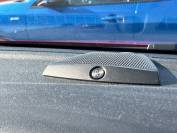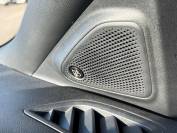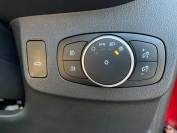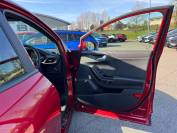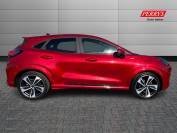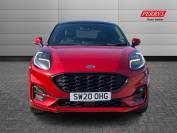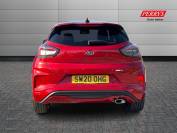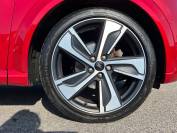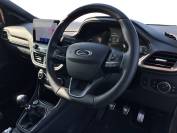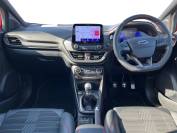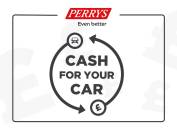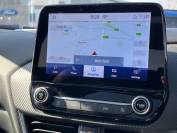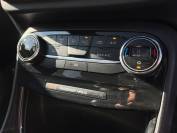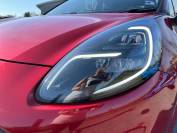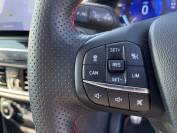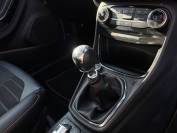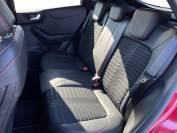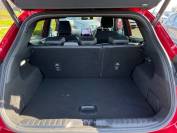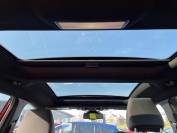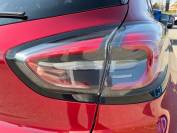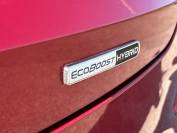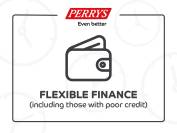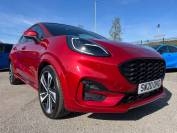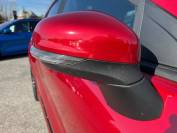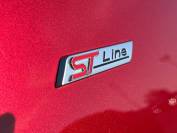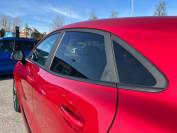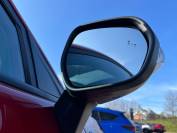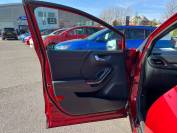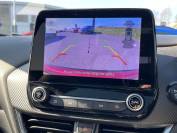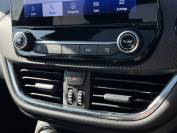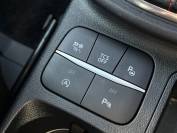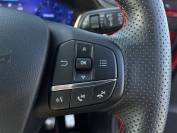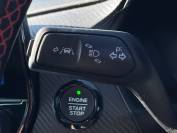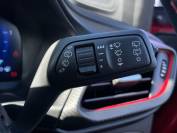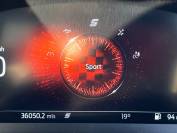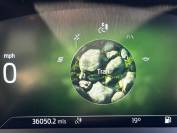FORD PUMA 2020 (20)
1.0 EcoBoost Hybrid mHEV 155 ST-Line X 1st Ed+ 5dr
FORD PUMA 2020 (20)
1.0 EcoBoost Hybrid mHEV 155 ST-Line X 1st Ed+ 5dr
Financial Disclosure
Perrys is Authorised and Regulated by the Financial Conduct Authority. (307639 ) Finance Subject to status. Other offers may be available but cannot be used in conjunction with this offer. We work with a number of carefully selected credit providers who may be able to offer you finance for your purchase. Perrys - 500 Pavilion Dr, Northampton NN4 7YJ. Companies House Number:972286. FCA number: 307639 .
Finance
We can introduce you to a limited number of lenders whose finance products will have different commission amounts payable to us for introducing you to them. This may be in the form of a fixed fee, a percentage of the balance financed, or another incentive.
The amount of commission that we expect to receive will be detailed to you clearly when we present you with a finance payment offer sheet. The exact commission amount payable to us will be presented to you once your finance proposal has been accepted, and always in good time before you complete any retail finance documentation with us.
We are a credit broker and will not provide you with impartial advice.
We actively monitor all finance transactions to ensure compliance and maintain transparency in all our dealings.
Any lenders we use will conduct a full credit search to decide if they can offer you finance. This search will show on your credit file and will be seen by other lenders. If the lender is unable to offer you finance, we will try up to three additional lenders, each of whom will record a search on your credit file. If these lenders are unable to offer you a finance agreement, we will then contact you and ask if you wish us to contact further lenders on your behalf.
Finance Products:
We will provide you with information to assist with your funding decision relating to Credit Agreements such as: Hire Purchase, Conditional Sale, Personal Contract Purchase (PCP), Personal Contract Hire (PCH) and Finance Leasing.
We will also send you Finance Product Information / Videos by email.
We do not charge you a fee for our services. Whichever lender we introduce you to, we will typically receive commission from them (either a fixed fee or a fixed percentage of the amount you borrow). A customer may ask for commission disclosure at any time from our initial discussions through to the point when their agreement is set live.

Independent Road Test Video & Review Courtesy of Car and Driving
Introduction
Back in 2019, the Puma model line was launched to serve the smallest, most fashionable end of the SUV segment. Frugal, fun and well connected, it fitted well with the spirit of its time and became a British best seller. But how good is it as a used buy?
Models
5dr SUV (Petrol - 1.0 EcoBoost, 1.5 EcoBoost, 1.5 TDCi diesel)
History
You might just remember the original Ford Puma - not the little SUV we look at here but a little coupe made around the turn of the century. By 2019, cars like that just weren't selling any more, so this model line reinvented itself as what Ford called an 'SUV-inspired Crossover'. Like the original Puma, this one was based on Fiesta engineering and was primarily powered by the mild hybrid 1.0-litre EcoBoost petrol engine the Blue Oval brand also used at the time in that supermini. Dynamic changes over the Fiesta included re-tuned suspension, bigger shock absorbers and a wider track. All of which built on the Fiesta's enviably dynamic feel to ensure that this car handled a little more sharply than recently launched direct class competitors of the time like Nissan's Juke, Volkswagen's T-Cross and Renault's Captur. You might well have gathered from this description that this car, launched in late 2019, was a very different thing from Ford's original attempt at a Fiesta-based small SUV, the largely unloved EcoSport, launched in 2014 and updated three years later. That car wasn't really designed for Europe but this one very definitely was, aiming to demonstrate what the Blue Oval brand could really do when it took this important segment seriously. It was good looking, efficient and spacious by class standards, with loads of clever interior touches too. The range was based around a 1.0-litre three cylinder EcoBoost mild hybrid petrol unit. Initially, Ford also offered the option of an entry-level un-electrified 1.0-litre EcoBoost petrol unit and a 1.5-litre TDCi diesel; both powerplants were quickly discontinued. In 2021, the brand introduced the Puma ST, initially launched with the Fiesta ST hot hatch's 200PS 1.5-litre four cylinder engine and manual transmission; a Puma ST automatic was launched in 2022 with a 170PS version of the three cylinder 1.0-litre EcoBoost mild hybrid unit.
What You Get
Visually, there's certainly a lot going on here - maybe even a hint of miniature Porsche Macan if you squint a bit. The unusual 'canoe-shaped' headlights are high up on the bonnet (like the first Puma) and Ford reckoned that the beady daytime running lights you get on 'ST-Line' variants were a nod to a more modern Ford coupe, the GT supercar. And from the side? Well most compact crossovers have a 'wedge'-style profile, something the designers here deliberately wanted to avoid. Hence the more distinctive silhouette with its undulating shoulder line, floating A-pillar, an angled crease that flows up from the front wheel arch and the exaggerated rear haunches. All disguising the fact that the bits you can't see come straight from a humble Fiesta. This Puma sits on the same 'Global B' platform as that car and though the suspension bolted to it is pretty bespoke, the under-bonnet stuff is pretty much identical too. Inside, there are certainly lots of Fiesta parts carried over but you get a bespoke digital instrument cluster screen and you sit 60mm higher than you would in that car. Particularly with pricier variants, you might wish that cabin had less of a supermini ambiance, but the designers clearly tried to do what they could to give this interior a special and lifestyle-orientated feel - things like the cool silver trimming for both the gear knob and the (strangely conventional) handbrake. And the 'ST-Line' variant's carbon-style fascia finishing, red highlights around the outer vents and red stitching. The 12.3-inch instrument cluster screen, fitted from ST-Line trim upwards, springs into life when you select one of the driving modes and is almost infinitely customisable with information between the two virtual gauges. Anything this display can't tell you will probably be covered off by the 8.0-litre SYNC3 centre-dash monitor. It offers helpful shortcut 'Audio', 'Phone', 'Navigation', 'Apps' and 'Settings' press selections at the base of the screen and incorporates an excellent quality 7-speaker DAB sound system - which was optionally upgradeable to a 10-speaker B&O premium set-up. All-round visibility could be better, but there are plenty of places to store things and a brilliant standard of media connectivity, with a built-in embedded FordPass Connect WiFi modem, plenty of connectivity ports and a standard wireless charging mat And the rear? Well our hopes weren't especially high here: a Fiesta is, after all, somewhat on the cramped side at the back and despite its lengthier platform, this Crossover isn't much bigger than one of those. But it would make a lot more sense than a supermini as a second family car. True, the small side windows don't help to create much of a roomy feel and if you've lanky teenagers to ferry about, we'd steer you clear of models fitted with the optional panoramic glass roof, which eats into head room. Otherwise though, a couple of six-footers would be comfortable enough, helped by the way they could slide their big size 10s under the seat in front, though there's less leg and knee room than you'd get in segment rivals like the Skoda Kamiq and the Volkswagen T-Roc. Out back, a handsfree powered tailgate was optional, but you don't really need it because the hatch is light to lift and opens to reveal something unusual: a decently-sized boot in a small Ford. This one has a 456-litre capacity - one of the largest in the segment. When you lift the tailgate, the parcel shelf rises out of the way with it, flat against the tailgate glass. Equally neat is the adjustable-height boot floor, beneath which lies this 68-litre recessed well - Ford enthusiastically called it a 'Megabox'- which allows you to carry tall items like electrical equipment upright. Push forward the 60:40-split rear backrest and a 1,216-litre space reveals itself.
What You Pay
There's a wide choice when it comes to used Puma models. Prices for this pre-facelift model start from around £11,600 (around £13,700 retail) for an early '19-era 1.0-litre EcoBoost petrol 'Titanium'-spec variant, with values rising to around £15,800 (around £17,900 retail) for one of the last equivalently-specced pre-facelift models. Allow a premium of around £1,700 over those prices for the 'ST-Line'-spec version you're more likely to find. We'd be tempted to try and stretch to the Puma ST, which in 1.5-litre manual form values from around £17,000 on an early '20-plate (around £19,000 retail), with values rising to around £21,500 (around £23,750 retail0 for one of the last mid-2024 manual ST models. All quoted values are sourced through industry experts cap hpi. Click here for a free valuation.
What to Look For
We found lots of satisfied Puma customers but inevitably, our survey revealed quite a few issues too. The general things to look out for with used Pumas are engine over-heating, SYNC 4 system software glitches and mild hybrid system issues. We've heard of problems with the engine management light illuminating, usually because of sensor problems or software faults. And the mild hybrid engine is known for battery performance issues in cold weather. Some owners have reported coolant leaks and failing water pumps. And some of the cabin trim is cheap and damages easily. Make sure the car you're looking at has had the various product recalls dealt with; Ford issued those for loose hybrid battery connections, software issues affecting the e-call system and driver's airbag problems. Thoroughly check the SYNC 4 infotainment system, including navigation and Bluetooth-linking. www.fordownersclub.com is a good forum to discover faults. You'll need to look for the usual scratched alloys and evidence of child damage in the back. As usual, check that the service book is fully stamped up to date. Some ex-fleet models may have missed out on garage visits.
Replacement Parts
(approx based on a 2020 Puma 1.0 EcoBoost 125PS mHEV - Ex Vat -autodoc.co.uk) An air filter costs around £11-£20 and an oil filter costs in the £6-£20 bracket. Front brake pads sit in the £33 to £135 bracket for a set. Rear brake pads sit in the £22-£68 bracket for a set. Front brake discs sit in the £27-£160 bracket. Rear discs are in the £23-£51 bracket. Wiper blades cost in the £7 to £18 bracket. A water pump costs in the £52 to £95 bracket. A radiator costs in the £77 to £193 bracket.
On the Road
Back in 2020, we'd been waiting a long time for a small Crossover that was genuinely good to drive. Well this was it. Given that the Puma drew so heavily on the car that back in 2020 was the supermini class benchmark in this regard, Ford's Fiesta, you could argue that the creators of this SUV didn't have to try too hard in this regard, but they did manage to mess things up with the brand's previous entrant in this segment, the old Ecosport. The Puma was very different. It's slightly impaired - yes of course it is - by the high-sidedness and slight extra weight that afflicts all little SUVs of this kind, but the compromises here were kept to a minimum and thanks to suspension embellishments and a great torque vectoring system, the car turns into corners at speed really keenly. If you're driving like this, you'll want to set the 'Selectable Drive Mode' system to the 'Sport' mode that firms up the steering. And you'll enjoy even more the benefits of the electrified tech that has a lot to do with the ready eagerness we just referenced. Almost all models were sold with the mHEV mild hybrid engine, a variation on Ford's usual 1.0-litre three cylinder EcoBoost petrol unit that in this case was mainly offered in 125PS form but was also available in an uprated mainstream 155PS guise. Mild hybrid engineering is nothing like as efficient as full-Hybrid tech, but it doesn't come with a big fat price premium and it boosts driver feel because it's lighter and it adds a slice of extra pulling power just when you need it. The set-up works via a beefed-up starter/generator driven by a belt at the front of the engine that stores the energy harvested when you brake or decelerate in a tiny 48-volt lithium-ion battery secreted at the back of the car. Which provides a bit of extra zip when you accelerate (Ford says up to 50Nm of extra torque) and delivers a little electric boost from low revs to 'torque-fill' while you're waiting for the turbo to spool up. That has a lot to do with this car's fizzy, revvy feel. But it also plays its part in creating efficiency stats usefully improved over those you'd get from conventionally-engined rivals in this class. There was a choice of 6-speed manual or 7-speed dual clutch transmission. Initially, Ford also offered the option of an entry-level un-electrified 1.0-litre EcoBoost petrol unit and a 1.5-litre TDCi diesel; both powerplants were quickly discontinued. In 2021, the brand introduced the Puma ST, initially launched with the Fiesta ST hot hatch's 200PS 1.5-litre four cylinder engine and manual transmission; a Puma ST automatic was launched in 2022 with a 170PS version of the three cylinder 1.0-litre EcoBoost mild hybrid unit.
Overall
Ford's decision to re-use the Puma name wasn't universally popular amongst enthusiasts for the original model, but that doesn't matter much. After all, for the target market here, this car's badge is more likely to suggest sports ware or trainers than a classically-styled sports coupe. And that lifestyle orientation fits with the kind of little SUV this Ford is trying to be - active, trendy, charismatic and current. Back in 2019, having moved its third generation Kuga SUV a little up-market, Ford needed a more credible entry-level point for its SUV line-up and this Puma filled that role very well, while setting fresh standards for the kind of driving enjoyment a little car of this kind could serve up. As enthusiasts, we still can't help wishing it was a small coupe. But as pragmatists, we reckon Ford got this car just about right.































































